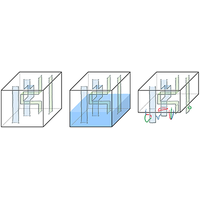Abstract
We present a scheme for universal topological quantum computation based on Clifford-complete braiding and fusion of symmetry defects in the 3-fermion anyon theory, supplemented with magic state injection. We formulate a fault-tolerant measurement-based realization of this computational scheme on the lattice using ground states of the Walker-Wang model for the 3-fermion anyon theory with symmetry defects. The Walker-Wang measurement-based topological quantum computation paradigm that we introduce provides a general construction of computational resource states with thermally stable symmetry-protected topological order. We also demonstrate how symmetry defects of the 3-fermion anyon theory can be realized in a two-dimensional subsystem code due to Bombín—making contact with an alternative implementation of the 3-fermion defect-computation scheme via code deformations.
27 More- Received 23 December 2021
- Revised 23 August 2023
- Accepted 8 September 2023
DOI:https://doi.org/10.1103/PRXQuantum.5.010315
Published by the American Physical Society under the terms of the Creative Commons Attribution 4.0 International license. Further distribution of this work must maintain attribution to the author(s) and the published article's title, journal citation, and DOI.
Published by the American Physical Society
Physics Subject Headings (PhySH)
Popular Summary
Large-scale quantum computers promise to revolutionize the way we solve many important information-processing tasks. Essential to their design is the use of quantum error correction in order to protect delicate quantum information from noise due to imperfect components and operations as well as unwanted interactions with the environment. Significant advances in fault-tolerant quantum computation have been made by developing schemes based on exotic interacting spin models in two-dimensional (2D) lattices called topological phases, but despite many advances, the resource requirements to implement these complex quantum error-correction schemes remain a formidable challenge. Moving from two to three dimensions, the possible phases of matter are much richer, but it is not known how to utilize them for quantum computation.
In this work, we harness the topological order of a rich set of three-dimensional (3D) spin lattices for fault-tolerant quantum computation, offering compelling alternatives to the main approaches that are currently being pursued. With these exotic models, information can be encoded and protected on their 2D boundaries—acting as a topological quantum memory—and processed using measurements on individual spin qubits in the 3D bulk. Focusing on a promising example known as the 3-fermion model, we show how to perform a universal set of fault-tolerant gates by leveraging the underlying symmetries of the model to create defects in the spin lattice (akin to crystal defects). The computational scheme we present is inherently robust, as errors on the spins can be detected using the same measurements that drive the computation and subsequently corrected.
Our computational scheme provides an ingress to exploit the exotic physics present in 3D topological phases to perform efficient fault-tolerant gates on protected qubits that may enable large-scale quantum computation to be realized in the near future.



